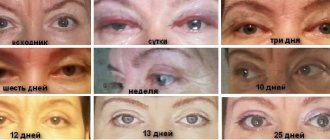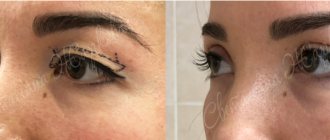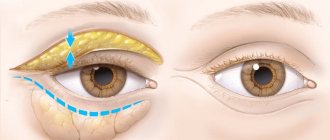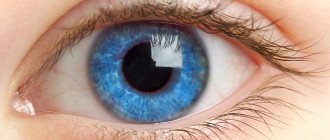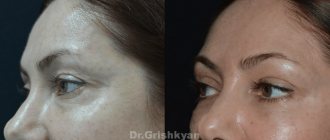Like any surgical procedure, blepharoplasty can have unpleasant consequences. It is imperative to take a responsible approach to choosing a clinic and a plastic surgeon who will perform the operation. However, even these actions do not guarantee a 100% positive result.
During the consultation before the operation, the doctor is obliged to inform the patient about the possible unforeseen consequences of blepharoplasty.
There are 3 common types of claims made by those undergoing surgery:
- Surgical . Development of blepharoptosis, postoperative swelling, eye asymmetry;
- Psychological . In case of unreasonably high expectations from the operation;
- Physiological . Scars, slow healing.
Blepharoplasty: consequences of unsuccessful surgery
Conventionally, complications after surgery can be divided into:
- temporary complications of the early period that do not require repeated intervention and disappear on their own over time;
- complex, the occurrence of which requires repeated surgery or continued treatment.
The first group usually includes hematomas and swelling that occur in the early postoperative period. Such consequences are caused by injury to small vessels as a result of dissection of soft tissue. Hematomas will go away on their own; if you apply cold compresses, recovery will speed up.
Important! The presence of bruises may indicate that large vessels were hit. This condition requires immediate surgical intervention.
Swelling occurs after almost any blepharoplasty. Bags under the eyes, in most cases, disappear within a week, however, sometimes the recovery period can take up to three months.
In some cases, after blepharoplasty, tearing occurs. As a last resort, if it is impossible to correct the problem locally, probing of the lacrimal canal can be used.
It is possible to develop allergic reactions to the administered drugs and dressings. If necessary, the attending doctor prescribes antihistamines.
After operation
After eyelid surgery, a bandage is applied and eye drops are instilled to prevent swelling. There is no pain, bed rest is recommended for the next 2-3 hours. The cosmetic micro-suture is removed by pulling on 4-5 days absolutely painlessly. By the 6-7th day, minor swelling disappears and you can return to everyday life.
But according to most patients, the final result is determined only by the second or third month.
Problems after unsuccessful blepharoplasty of the upper and lower eyelids
After an unsuccessful operation, the following complications may occur:
- Seam divergence;
- Drooping of the upper eyelid;
- Eversion of the lower eyelid;
- Asymmetrical eyes.
The most common consequences of unsuccessful upper blepharoplasty:
- inversion of the upper eyelid;
- eye asymmetry;
- hematomas and swelling;
- retrobulbar and subcutaneous hematomas.
After lower blepharoplasty, the following are possible:
- drooping eyelid;
- swelling;
- asymmetry;
- eversion of the eyelid;
- divergence of seams.
All the consequences of unsuccessful operations described above necessarily require a repeat operation. The faster the consequences are corrected, the sooner you will achieve the desired result.
Who is the procedure suitable for?
Indications for intervention include age-related changes and congenital pathologies of the upper eyelid:
- loose overhanging skin;
- wrinkles, creases and folds;
- fatty hernias;
- overhanging soft tissues, provoking the effect of a sad and tired look;
- congenital or acquired asymmetry;
- hypertrophy of the circular muscles in the periorbital zone;
- swelling;
- turning of the eyelids.
In some cases, cosmetic imperfections cause both psychological and physical discomfort. Over time, upper eyelid ptosis can lead to blurred vision, drooping eyelashes, and eye irritation. The constant need to strain the facial muscles to keep the eyes open leads to the formation of wrinkles on the forehead, in the area of the nasolabial folds and other areas.
Contraindications:
- pregnancy and lactation;
- increased intracranial or intraocular pressure;
- myopathy;
- corneal infections;
- impaired blood clotting;
- oncological pathologies;
- exacerbation of chronic diseases and infections;
- rehabilitation after ophthalmological interventions.
| Facial plastic surgery – Dr. Amjad Al-Yousef | |
| Upper blepharoplasty (eyelid surgery) | 95,000 rub. |
| Eyelid surgery with canthopexy | RUB 105,000 |
| Upper eyelid surgery with asymmetry correction | RUB 105,000 |
| Facial plastic surgery - Anna Petrovna Pershukova | |
| Upper blepharoplasty (eyelid surgery) | 55,000 rub. |
| Upper eyelid surgery with asymmetry correction | 60,000 rub. |
| Facial plastic surgery - Dr. Youssef Bassanovich Dergam Prices include a promotion with a 50% discount with permission to publish the results of photos and videos | |
| Upper blepharoplasty (eyelid surgery) | 40,000 rubles instead of 80,000 rubles |
| Upper eyelid surgery with asymmetry correction | 45,000 rubles instead of 90,000 rubles |
| Facial plastic surgery - Dr. Ivan Pavlovich Chesalin Prices include a promotion with a 50% discount with permission to publish the results of photos and videos | |
| Upper blepharoplasty (eyelid surgery) | 40,000 rubles instead of 80,000 rubles |
| Upper eyelid surgery with asymmetry correction | 45,000 rubles instead of 90,000 rubles |
Why might the operation fail?
Unfortunately, the most common reason for a failed operation is insufficient qualifications or mistakes by the surgeon. Therefore, we recommend that you approach the choice of the doctor who will perform the operation as carefully as possible. This must be an experienced surgeon who has had a sufficient number of successful operations in this area. The clinic where blepharoplasty will be performed must have all the necessary modern equipment for eyelid correction.
Remember that proper preparation for surgery and compliance with all doctor’s recommendations is the key to successful correction!
However, you should not place all responsibility for the result of the operation on the plastic surgeon alone. Most complications depend on the individual characteristics of the patient’s body.
Dressing for 5-7 days.
On the dressing we see that the skin has healed perfectly, the process of epithelization has completely occurred. The seam looks like a thin narrow pink stripe, which will turn white over time and become even less noticeable. We see that the cut is located in the correct position, in the fold, which also ensures its inconspicuousness. But at the same time, we see that the skin fold at this stage is swollen, that is, there is a little more skin than needed due to swelling. The patient asks me: “Sergei Vladimirovich, was it possible to remove more skin?” How to answer this question? Of course it is possible, but then there would be a void in the upper eyelid, which would give age, rather than a rejuvenation effect. If I removed all the skin, we would get significant changes in the upper eyelids and this could become very unusual for the patient and the patient could be upset, but most importantly, there would be an emptiness effect. The skin of the upper eyelids is now swollen, stretched, and the skin hurts. But when 4 months pass and the swelling completely goes away and the skin of the upper eyelid shrinks. The excess that exists will go away in 4-6 months due to skin contraction. In addition, we need a small excess so that we can perform a brow lift in the future. If we completely remove all the skin and then we decide to perform an endoscopic brow lift, a situation may arise where there is not enough skin, there will be excess tension. In this situation, there will be contraindications for a brow lift, so in this case the skin is removed with the expectation that the next brow lift operation will be performed and the skin will be completely straightened, and there will be no excess, and there will be no emptiness of the upper eyelid, this is very important to plan sequence of the operation and at each stage to obtain a good aesthetic result.
Common Complications
Let's take a closer look at the negative consequences of unsuccessful eyelid blepharoplasty:
- Diplopia . This consequence is double vision of the eye, which occurs as a result of trauma to the eye muscles. This problem most often occurs during lower eyelid blepharoplasty. In this case, urgent surgical intervention by an ophthalmologist is necessary.
- Retrobulbar hematoma . Formed as a result of blood clots forming behind the eyeball. A characteristic sign of the formation of pathology is protrusion of the eyeball forward. This is a dangerous situation for the patient and requires immediate surgery, otherwise vision loss is possible.
- Blepharoptosis . A disease characterized by drooping of the upper eyelid. Most often it occurs in one eye. The most common problem among older patients. Blepharoptosis occurs due to damage to the muscles of the eye and requires surgical intervention.
- Decreased and complete loss of vision . Unfortunately, no patient is immune from such an outcome. In most cases, the problem occurs as a result of large swelling; hemorrhages in the orbit are not excluded. If you feel something is wrong with your vision, immediately consult a doctor to take the necessary measures, this will help preserve your vision.
- Ectropion of the eye . It is an eversion and retraction of the eyelid. The problem can affect both the upper and lower eyelids. Cases of ectropion of both eyelids have been reported. If the situation is minor, you can get by with a simple massage. However, in most cases, repeat surgery will be required. Only your attending physician can assess the degree of complexity of the situation.
- Inflammation of the eye membranes and non-closure of the eyelids. Such complications most often arise as a result of violation of sanitary and hygienic standards during surgery or during the rehabilitation period. If you strictly follow all the doctor’s recommendations, the problem will be solved in a short time. Eyelid closure will become normal after three weeks after blepharoplasty. In this case, you can do without repeated surgery.
- Dry eye syndrome . This is one of the most common consequences of blepharoplasty. The doctor will select the right drug for you to help get rid of the discomfort.
Check-up in a month.
Comparison of before and after results.
The patient asks me: “Sergei Vladimirovich, could you have removed more skin, you see, I still have a small fold left?” Of course, it was possible to remove it, but with a brow lift, a skin deficit would then arise. After all, a brow lift moves the skin of the upper eyelid higher. If, at the first stage, with eyelid plastic surgery, we remove all the skin, then at the second stage, after 6 years with a brow lift, we will not have enough skin to move the eyebrow upward, because the skin of the upper eyelid is also pulled up behind the eyebrow, so this a small excess was left specifically in the expectation that we will perform a brow lift in the near future, since there are indications for raising the eyebrows, that is, the patient has drooping eyebrows. When we plan such a 2-stage approach, we must take into account what we will have if we remove more skin, how the condition of the tissues will change, whether we will have enough skin for a brow lift if we remove it all, where we will end up with a seam after eyelid surgery if we then perform a brow lift. All these moments need to be predicted at the stage of eyelid surgery. If, on the contrary, we first perform a brow lift, and then 10 months later an upper eyelid plastic surgery, then we would remove as much skin as we need, since the tissue would already be moved due to the brow lift and we would not have to leave a small reserve of skin for centuries.
Comparison of results after 1 month.
Comparison of results after 6 months.
Comparison of results after 1 year.
Non-surgical blepharoplasty
If your situation is not life-threatening, and the fear of complications is too great, it is worth considering methods of performing blepharoplasty without surgery. Here are the main ones:
- thermage;
- hardware;
- injection
- sms-lifting;
- thermolifting
Of course, these methods also have their drawbacks, but they are much less than those of operating procedures. One of the main disadvantages is the presence of swelling for some time after the operation. However, this lasts no more than a week.
Advantages of blepharoplasty without surgery:
- safety of the method;
- targeted impact on the desired area;
- low trauma;
- no pain during the procedure;
- quickly get the desired result
If you decide to undergo non-surgical blepharoplasty, remember that several procedures are necessary to obtain the desired result.
How to prevent an unsuccessful outcome?
The natural desire of the patient before undergoing surgery is to be able to insure against complications after the procedure. Therefore, we strongly recommend that you carefully consider the preparation of the operation and calculate all possible troubles. Most of the possible problems can be prevented; all you need to do is choose the right clinic and plastic surgeon.
Choosing the right doctor
The main task is to choose a surgeon who is a specialist in the area you need. With the right choice, the possibility of a negative outcome from the operation will be reduced to zero. A doctor with extensive experience and status simply cannot afford to make a mistake, and performs all his actions impeccably and with the utmost care. An experienced surgeon can calculate in advance all possible unpleasant consequences and will do everything to prevent this.
Important! If blepharoplasty is performed incorrectly, it will be impossible to completely eliminate errors. It is realistic to only correct the errors as much as possible during a repeat operation.
Anything associated with surgery in the eye area is surrounded by significant risks due to the fragility of eye tissue. In some cases, the problems may resolve on their own, but for the most part, repeat blepharoplasty will be necessary.
The importance of following recommendations
Immediately after blepharoplasty, the patient is sent to the ward, and a cooled bandage is applied to the eyes to reduce swelling and relieve pain. In the postoperative period, it is most important to strictly follow the recommendations of the attending physician, since the operation is accompanied by certain changes in the condition.
The patient must remain in bed for 24 hours after blepharoplasty. You can only lie on the back of your head to avoid injury and reduce swelling.
After the operation, you must follow these recommendations:
- use any medications only under the supervision of a doctor;
- temporarily avoid solid foods and chewing gum;
- do not be in direct sunlight;
- wash your hair for the first time only after consulting a doctor;
- women are allowed to apply makeup only 10 days after blepharoplasty;
- To avoid swelling, minimize the consumption of spicy and salty foods
- stop smoking;
- consultations with a doctor for a year after surgery, following all recommendations.
Remember! Each body is individual, so all prohibitions and recommendations should be discussed with your doctor in more detail.
If you do not follow the above recommendations, you risk reducing your blepharoplasty to zero and causing serious health problems.
PREOPERATIVE CONSULTATION.
Patient complaints.
“Ever since my youth, when I was 20 years old, I have always had the problem of drooping eyelids. Problems with makeup to apply a line of arrows. Accordingly, with age, the fold only increased and became worse and worse. Age-related changes cannot be avoided, the time has come, it’s time.”
Conversation between doctor and patient.
During the consultation, medical indications are determined. The patient has an excess skin fold of the upper eyelid. The first problem is that the crease hangs over and interferes with applying makeup; it can be a little irritating, especially during the period when there is slight swelling, as it gets larger and interferes with taking beautiful photographs. I don’t like his appearance, he’s tired and gloomy. The second problem is the position of the eyebrows. It's different for everyone. In this situation, the position of the eyebrows is quite low and this cannot be ignored, because the patient is indicated for 2 operations: plastic surgery of the upper eyelids and subsequently endoscopic brow lift.
Taking photographs.
Medical photography is a standard procedure related to medical documentation. You cannot perform aesthetic surgeries to change your appearance or correct age-related changes or birth defects without photographs. We need photography to evaluate the results before and after. Photographing is performed in 3 projections: frontal, lateral and semi-lateral, with eyes closed and open. In these positions it will be clearly visible what excess skin of periorbital hernias was before the operation and what result we will get in the end.
Marking.
An important step before surgery. At the preoperative marking stage, it is important to assess the volume of skin that is to be removed. It is known that there are certain limits, these are 9 mm from the eyelash edge and 15 mm from the eyebrow growth line. Within these limits, the skin fold can be removed. You cannot remove any more, otherwise you may get a noticeable scar that will not fit into the fold of the upper eyelid. You may also get the effect of emptiness in the area of the upper eyelid, which makes you look older and gives you age. And our goal is to get a rejuvenation effect. Therefore, it is important to consider how much skin and fatty periorbital hernias to remove. You can't do hypercorrection, because... This will make you look older and look exhausted. It is better not to remove more tissue than to go through it during surgery. But another important point is that when we potentially know that there will be a brow lift surgery, we should not remove too much skin. Otherwise, in the future, when raising the eyebrows, there will be excessive tension, as well as the effect of emptiness of the upper eyelid and tension when closing the eyes. But another important point is the cut. When we first perform upper eyelid surgery and then endoscopic brow lift, we must take into account how we will draw the incision line, since when the eyebrow is raised, the incision may extend onto the eyebrow and become noticeable.
Elimination of consequences
If you still cannot avoid complications after blepharoplasty, you will need a repeat operation. If you trust your doctor and are sure that the consequences are not his fault, you can trust him with the correction. If a doctor makes a mistake during an operation, it is worth looking for another clinic and surgeon. Only a doctor with extensive experience and qualifications will be able to assess the degree of complications and draw up a plan to eliminate them.
In some cases, drug treatment will help, but for more severe complications, surgical intervention is necessary.
Repeated blepharoplasty
You should not be afraid of having a repeat operation; a competent specialist will help correct the situation with minimal losses. Try to collect as much information as possible about surgeons and clinics where they perform blepharoplasty. Look for real reviews on the Internet, on forums or on the website of the clinic itself. A self-respecting clinic will not post false reviews about its specialists.
What is additional correction
In cases where surgery can be avoided, correction will help. This includes physiotherapy, lymphatic drainage or medication.
Remember that the responsibility for the successful outcome of the operation lies with you. It is up to you to find a professional who will perform the operation competently and as accurately as possible. On our website you can get acquainted with clinics that perform blepharoplasty in Moscow and other cities of Russia, study prices, equipment, and a list of surgeons.
Finally, we recommend that you look at photos of patients who have had unsuccessful surgery.
